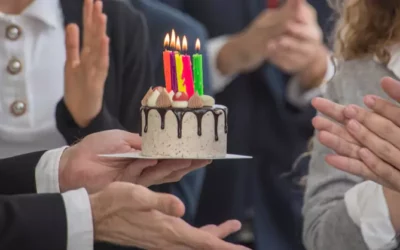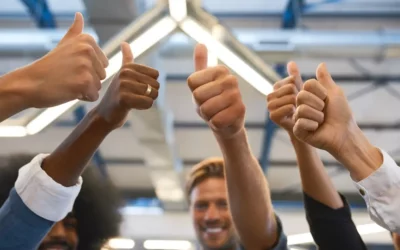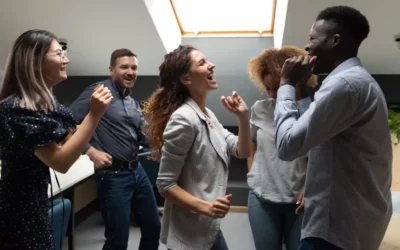“We spend too much time at work for it to not be fun, meaningful, and engaging.“
Sam McKee has been a fan of Team Building Hub long before we offered virtual events. His company, Evergreen Leadership, has been using our escape rooms to enhance their leadership programs for years! Today, he shares insights from his time as an executive coach, and his thoughts on company culture, leadership, and more.
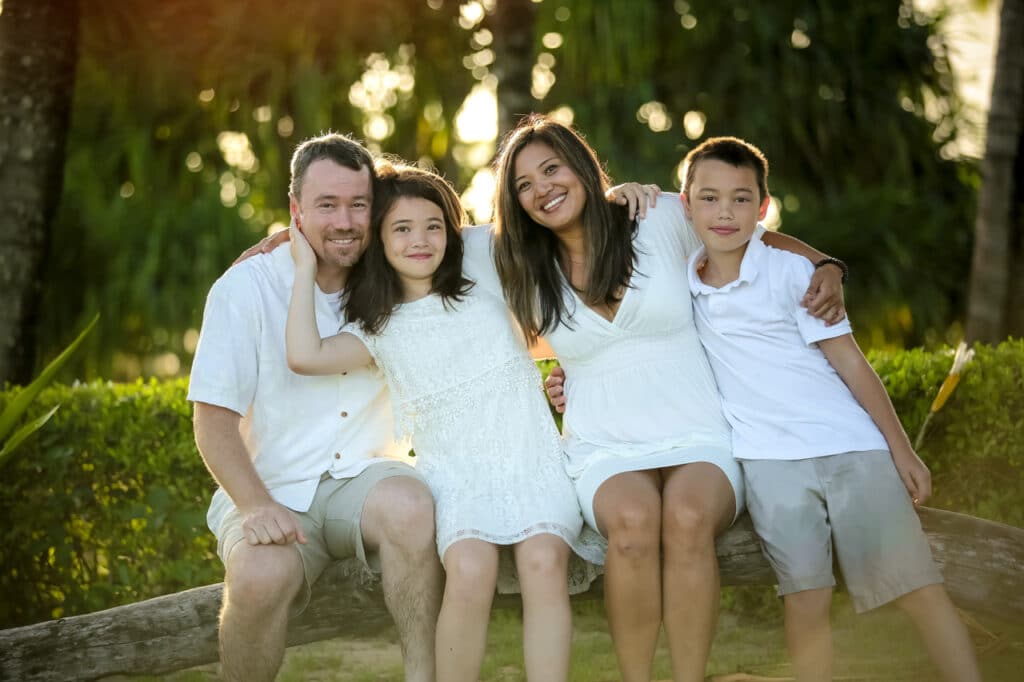
Hey Sam! Let’s start simple – tell me a little bit about yourself, as though we’ve never met before.
Oh man! If I were going to sum up my whole life’s story, I would say that I love designing and leading a team that delivers transformational leadership programs for a wide variety of teams. Anywhere from aerial firefighting pilots, to folks that make candy, pet food, tires, and cranberries!
You name it, we love rolling up our sleeves and finding out the visions and values of a company, their biggest obstacles, and then designing transformational and fun experiences. We want the leaders to walk away with tools and habits that bring out the best in their people. We spend too much time at work for it to not be fun, meaningful, and engaging.
That’s so true. What were you doing before Evergreen Leadership?
That’s a powerful question, because I never expected to be doing what I’m doing now!
I started out as a journalist working for a newspaper in Chicago and then went to graduate school, and started working with teenagers, non profits, and churches. I wanted to help those with fewer resources, both near and far.
We would take teenagers from the US to Mexico, and build a house in 3 days from scratch, with no power tools. We would connect with the locals, eat with them, play soccer with them, and then get to hand them the keys to their new house. We also helped start an orphanage in Uganda. In the US, we worked with mothers who were trying to get clean and get their kids back.
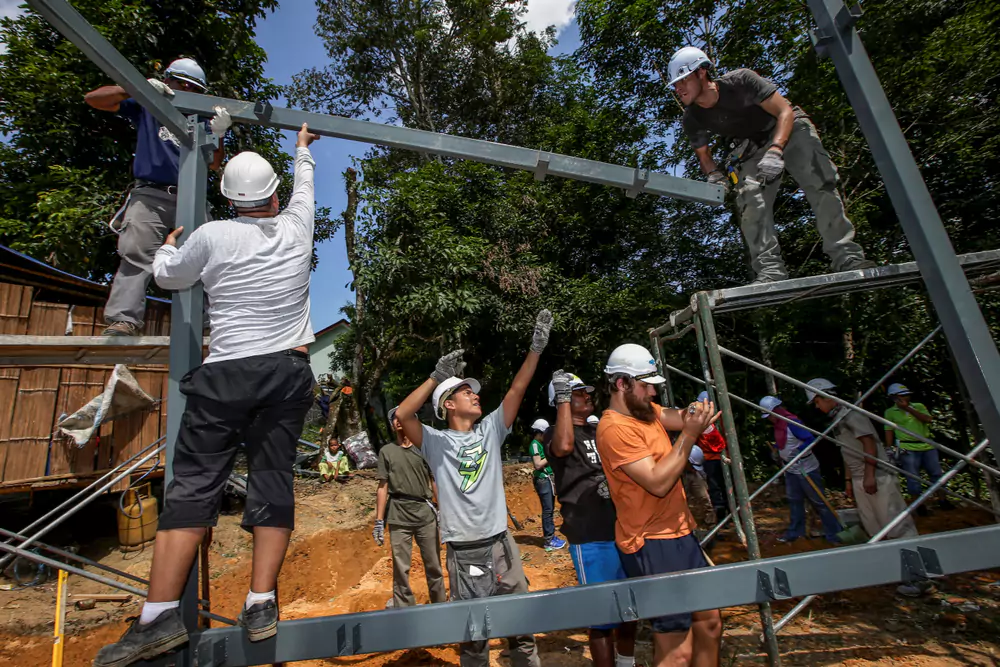
My son was born with numerous medical conditions, including 5 life threatening allergies. And Stanford University Medical Center basically told me, “You’re going to need to get a more profitable career!”
I was already in Silicon Valley, working with some incredible companies like Apple and Google, and some colleagues said, “Why don’t you become an executive coach?”
I thought there was no way – I had no business experience. I didn’t even know what a CFO was! But that’s the great part about a consultant vs a coach. A consultant is paid to provide answers. A coach is there to ask questions and help people find their own answers and solutions.
As a coach, I really sit back and listen while people solve their own problems. And I really think it’s better than a consultant, in a way. After a session, instead of walking away thinking, “Wow, that Sam guy is so smart!”, teams walk away thinking about how smart they are, and how they had the answers inside them all along. It encourages them to work to solve their problems internally.
Somewhere along the line, I got hooked up with a Mars leadership program, and through that, learned a lot about different businesses and the challenges they face. From that experience, I began to design experiences for individual teams and transformational leadership programs that can cross all functions and locations.
What was the biggest problem you were trying to solve with Evergreen Leadership?
I think what companies need more than anything are amazing leaders that inspire people with purpose. What I mean by that is that people work hard for a paycheck. They work harder for a person. And they work hardest for a purpose.
If you are the kind of person that people want to give their all to, because they know you’ve given your all to them as a leader, that’s an incredibly powerful thing. You can go beyond that, and really help them understand their own purpose and motivation, maybe even their dream.
The greatest leaders I’ve worked with have been selfless, not only being the kind of person that people want to work for, but helping people find their own purpose, even if that purpose goes beyond their company and their role.
Give your all to your team and they will give it back to you.
It’s that kind of selfless leadership that really cares deeply about others, but challenges them directly towards excellence – that’s a quote from Radical Candor.
Whether you have a great place to work or a crappy place to work really depends on who you work for and with. Great leadership really helps the work and success become sustainable.

So, 2020, start of the pandemic. How did you witness that affect teams and leaders you were working with?
For years, people knew and acknowledged that we lived in a volatile world and needed agility. Of course, we had no idea how much agility we really did need! From my perspective, we saw people pivot and use the same leadership principles but in new ways. Care personally, have empathy for your people, build trust and a connection, and be adaptable, manage to the result.
In the case of my company, instead of sharing a meal and conversation in person, we had Uber Eats delivered. We had our team share slides about themselves, their family, their hometowns, and we shared more than we potentially would have in person.
The methods changed but the principles did not.
How do you think that ethos continues to apply, or doesn’t, in 2022? So many people are still working remotely, or even have a hybrid working situation.
Yeah – for me personally, I feel like I can do a great job virtually, or I can do a great job in person, but trying to do a great job with one foot in each is really difficult. My most difficult meetings are the hybrid ones, with some folks in person and some just logging on. It’s like my brain is working twice as hard!
What I’ve noticed as people have started to come back in person is that people have grown to appreciate it much more. We’ve noticed a lot more retention – we just had a meeting, 90 days after we had done a 3 day program, and we had a 95% return rate. Previously, I think people took for granted that connection in person. Now people are more appreciative and responsive.
I know this is a tricky question, but do you think leaders should continue to offer remote work? Should they be encouraging folks to come back to the office?
I think there are super smart people that are trying to figure this out right now. I hear a lot of the discussion about it, with leaders not able to force people to come back into office but wanting to see them there for the connection opportunities. It’s quite tricky.
I think we should make our moments together the most inspiring, creative, and impactful, to make people want to be together more. That’s part of the reason we partner with companies like yours, to try to do things in a way they’ve never seen. After you’ve made a powerful in person connection, it’s so much easier to nurture that remotely and makes that much more feasible.

What are some tips and tricks you can share about building a successful culture?
I would say, starting at the beginning, your company values should come out of the stories of your people, rather than the corporate wordsmithing and brainstorming sessions.
For example, I was working with an aerial fire fighting company in Montana. They had 10 value words on the wall, and I asked them what percentage of their employees they thought could name even 3 of those words? He said maybe 20%. I asked him what their mission was – “To be the global leader in aerospace solutions.”
And I said, “Gosh, does that fire you up? Does that make you want to run through the parking lot in the morning high fiving people? No! It sounds like a lame corporate thing – and you guys are out here every day risking your lives to save homes, firefighters and forests. What makes you proud to work here? To give your best?”
And he said, “Nick.”
Nick was a 14 year old kid. His dad was a tanker pilot, and flew into a canyon while fighting an enormous fire. He wasn’t able to gain enough elevation to get out, and his plane crashed. At 14 years old, a week after his dad’s funeral, Nick grabbed his dad’s tool kit out of the garage, carried it to the airplane hanger, and told all of the mechanics, “I want to fix planes and fight fires like my daddy did.”
And of course all these bearded airplane mechanics are wiping their eyes like, “Dang, kid, seasonal allergies got me going…”
Now, 17 years later, Nick is in charge of 150 of the most seasoned airplane mechanics. It’s an incredible story. It’s a resilient spirit, a phoenix rising up from the ashes.
I said, “Wow, that’s powerful. That’s great, let’s use that. Resilient spirit. What else would you take a bullet for?
And the CEO chimed in, “Integrity.”
I said, “That’s great. You know who else had that on their coffee mugs? Enron. What do you all call integrity here in Montana, how would you say it?”
And she said, “We call that a firm handshake.”
And I was like, “Put that on the planes, dang!”
So now, they use those values. They are a firefighting family with a firm handshake and a resilient spirit. And they give feedback and recognition based on those values. And it all comes out of their stories, when they’re at their best.

It’s important to push, to make sure you have the right values that come out of your people’s stories. They need to feel personal.
I know you guys have partnered with us for a long time to use our escape rooms for programs. Can you talk a bit about that?
Yeah! When we were first designing a new program for leadership at Bridgestone, we spent Day 1 talking about the diversity of personality and communications styles. My colleague Rachel Thomas said, “You know, I really think we need to have them bring this to life as part of Day 1, so they can look in the mirror thinking about their style, and look around at how different people have different strengths and communication styles.”
We decided to try bringing them to your escape room location on Broadway. And if it worked, we could do it every time.
Now, at this point, we’re something like 1,200 leaders later. We’ve been doing 20-24 weeks a year of this program, and we always wrap up Day 1 with an escape room from Team Building Hub. It’s an experiential demonstration and exploration of problem solving, with teams that have been engineered and designed and chosen to be diverse. To have different styles of communication, so we can ask them what they noticed about themselves? What did they notice about others? Did someone else’s style of thinking help solve the puzzle? Was there a different perspective you could have used in the room?
It’s really a great way to experientially, in a gamified way, showcase what we’re talking about with personality and communication. It’s fantastic.
Thank you so much, Sam! Any final thoughts you would share with leaders?
Leaders today are busier than ever – we really try to inspire and challenge.
At the end of any given meeting or training, make one crisp and clear commitment.. You probably don’t have time to take 5 generalized things from some leadership training. You need to commit to one thing, that connects to your needs, your goals, and your values. Commit to it, check in with your manager and your peers, and hold yourself accountable. 90 days later, you will be better in that one way. And that improvement will stick with you for life.
Get Your Free Game
The 3-Minute Non-Cringey Ice Breaker for Your Next Meeting
A ready-set-go game to run at your next fully remote or hybrid meeting without the hassle or added pressure of developing a team-building exercise yourself. Get it here →


